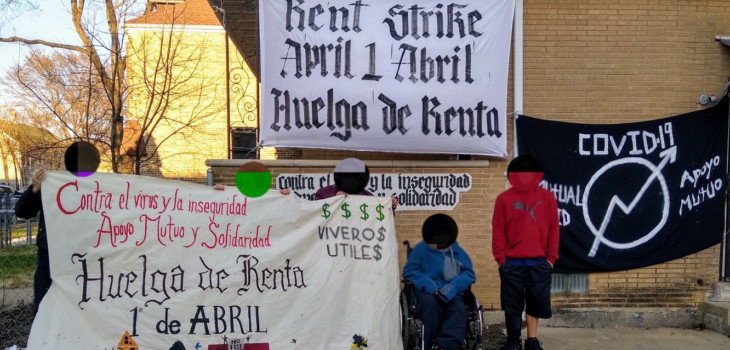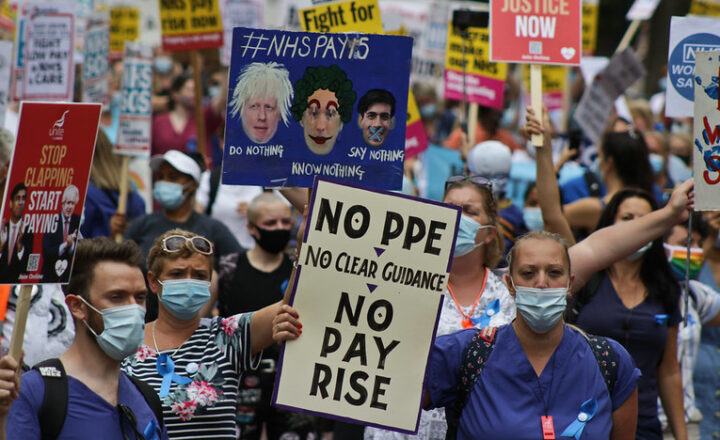Are people sunbathing in parks the real villains of the corona crisis? What about the corporations pushing industrial agriculture, Big Pharma companies locking up drug research, or the investment funds draining health services? What about the bosses refusing their workers paid leave, media barons spreading fear for ad-clicks, or governments using a pandemic as cover for power grabs?
This article looks at a few ways the economic system we call capitalism has been fundamental in spreading the virus – and in fostering a wider crisis of panic, repression, and looming poverty. And this is by no means a complete list. The general point is that capitalism, based on prioritising profits over people’s lives, is incapable of serving our health and well-being. To care for each other now and in the future, can we use our anger to fight for change?
Feature image above: occupation of Deutsche Bank owned building to create a mutual aid hub in Chicago, US

Medics protest against lack of resources in Athens, Greece
1. Industrial agriculture incubates new viruses
COVID-19 didn’t appear out of the blue. It is just the latest pandemic linked to industrial agriculture, and in particular the mass-scale production and sale of meat.
In this case, the disease has been traced to the Wuhan seafood market and to China’s “wild animal” trade, also implicated in the 2003 SARS pandemic. However, as biologist Rob Wallace, author of Big Farms Big Flu, makes clear: “this is no Chinese exceptionalism […] The U.S. and Europe have served as ground zeros for new influenzas as well, recently H5N2 and H5Nx, and their multinationals and neocolonial proxies drove the emergence of Ebola in West Africa and Zika in Brazil.”
The common factor is profit-driven intensive meat farming. “Zoonotic”, or cross-species infections from animals to humans, count for the majority of new human pathogens. Wallace identifies at least two common origin patterns. One is a leap from intensively farmed animals such as cows, pigs, chickens – as in the recent avian and swine flu pandemics. As he puts it:
“You couldn’t design a better system to breed deadly diseases. […] Growing genetic monocultures of domestic animals removes whatever immune firebreaks may be available to slow down transmission. Larger population sizes and densities facilitate greater rates of transmission. Such crowded conditions depress immune response. High throughput, a part of any industrial production, provides a continually renewed supply of susceptibles, the fuel for the evolution of virulence.”
Covid-19, like SARS or Ebola, appears to belong to the other pattern – in which the virus leaps from non-domesticated species. But again, capitalism plays a key role. The Chinese economy’s rapid growth drive and marketisation in the 1990s included corporate consolidation of agriculture, alongside major deforestation and destruction of biodiverse habitats. As smaller farmers were squeezed out of traditional livestock farming, one state-promoted strategy was to move into intensive breeding and farming of captive “wild” species. This led to further incursions into remaining forest areas and to new zoonotic infections, which can then spread rapidly through high-volume markets like Wuhan.
NB: see also this more detailed account by Wallace and other authors in Monthly Review; and this in-depth essay by Chuang journal examining how these factors played out in Wuhan and China.

2. Big Pharma diverts medical research
We still know relatively little about COVID-19 and its impacts. Although obviously dangerous, research is inconclusive as to precisely how virulent it will turn out to be, or how it can best be combated. But some issues are clear enough. One is the absence of drug treatments: no vaccine, and a lack of proven antiviral treatments.
Respiratory infections are well known to cause harm. So why is medical research so far behind on this area?
Much medical research is led by profit-chasing corporations – along with the universities and foundations they sponsor. One issue with the capitalist research model is that, because drugs are high value property, research data is guarded as “commercially confidential” rather than being shared for all to develop.
Another big problem is that drugs targeting respiratory viruses just aren’t that profitable. Adrian Hill, the professor who led UK research on the Ebola virus, has condemned the pharma industry’s “market failure” to tackle that pandemic in Africa. He explained in an interview with the Independent in 2014:
“Today, commercial vaccine supply is monopolised by four or five mega- companies – GSK, Sanofi, Merck, Pfizer – some of the biggest companies in the world. The problem with that is, even if you’ve got a way of making a vaccine, unless there’s a big market, it’s not worth the while of a mega-company …. There was no business case to make an Ebola vaccine for the people who needed it most.”
In a recent interview, Mike Davis – author of The Monster at Our Door: the Global Threat of Avian Flu – calls the problem: “Big Pharma’s abdication of the research and development of new antibiotics and antivirals.” He says:
“Of the eighteen largest pharmaceutical companies, fifteen have totally abandoned the field. Heart medicines, addictive tranquilizers, and treatments for male impotence are profit leaders, not the defenses against hospital infections, emergent diseases, and traditional tropical killers. A universal vaccine for influenza — that is to say, a vaccine that targets the immutable parts of the virus’s surface proteins — has been a possibility for decades but never profitable enough to be a priority.”
So in the US, as reported by Bloomberg, venture capitalists have poured $42 billion into drug development in the last three years. Nearly half of that has flooded into potentially lucrative treatments for cancer and rare diseases. Only 5% went into drugs that prevent infections.

Medics protest against lack of resources in Quetta, Pakistan
3. Markets decimate public healthcare
It started with a virus, but it’s the failure of our healthcare systems that have made this a serious health crisis. As well as lack of drugs, we can add the shortage of key equipment from testing kits to ventilators, down to masks and other basic protective clothing. And the shortage of hospital places, of doctors and nurses to treat people with severe symptoms. Whatever the real scale of the pandemic turns out to be, one thing is certain: because of these shortages, people will die.
Again, none of this comes as a surprise. In the UK, there have been repeated warnings, including the 2016 “Exercise Cygnus”, that the NHS couldn’t cope with a new pandemic. In fact, the NHS is in continual “winter crisis”: overwhelmed ICU wards and images of patients dying in the corridors are not extraordinary but regular events. With hospitals already at full stretch, it only takes a slightly more aggressive virus to turn this “normal” crisis level into something even worse.
This is not just a UK issue. In Italy, for example, the healthcare union USI identifies recent cuts of “43,000 workers (which means the loss of 70,000 beds, including 3,000 in intensive care).” They write that continuous funding cuts have:
“led to a widespread collapse of the healthcare system. As a result, access to treatment has been reduced for an increasing number of people. Today it is the coronavirus, tomorrow it could be another virus or even any trivial disease: to maintain only Essential Levels of Care (ELC) is to sign a death sentence.”
In the UK, the number of hospital beds has halved in 30 years. There are less than 3 hospital beds per thousand people and only 7 Intensive Care places for every 100,000 people.i Hospital places are just the most obvious indicator – all the same points could be made about testing facilities and other resources.
These health shortages are entirely avoidable: the UK and Italy are richer than ever before. The basic problem is that capitalism does not prioritise collective healthcare: the services we do have are concessions that people have won and defended through decades of struggle against “market forces”. In recent years, these victories have been eroded by privatisation and “austerity”.
In England for example, successive governments have failed to give the NHS the money it needs to care for a growing and ageing population. The other issue is where the money goes – much of it returns to corporate pockets. Here are just three examples of NHS profiteering:
- PFI debt. Debt on “private finance” schemes costs “up to £1 in every £6” of the budget for some NHS trusts, according to the IPPR thinktank. These were schemes pushed by the last Labour government in which hospitals were refurbished by borrowing from the private sector at extortionate long-term interest rates.
- Drug companies. According to The King‘s Fund, “estimated total NHS spending on medicines in England has grown from £13 billion in 2010/11 to £17.4 billion in 2016/17.” This is over 10% of the total NHS budget.
- Private health businesses and outsourcers. Much NHS work, for example cleaning or transport services, is now outsourced to profit-chasing companies. The latest development has involved handing contracts for actual medical services to private sector companies. These were worth £3.6 billion in 2019, with the biggest winners being Care UK and Richard Branson’s Virgin Care.

4. Work makes us sick
A well-prepared health system might respond to the virus with wide scale testing, plus hospital care for those hit by severe symptoms. Instead we get a brutal last-ditch measure: mass lockdown. Medics hope this can slow the pandemic so that fragile health services aren’t overwhelmed. Many governments are happy to seize the opportunity and race through new police state powers.
But here too, the capitalist drive for profit takes precedence. Even as police and public outrage target “irresponsible” individuals taking some air, workers are still being crowded into factories, building sites, and tube trains.
The European corona epicentre so far has been Lombardy, Northern Italy. This is Italy’s “industrial heartland”: the home of steel mills, car plants, textiles factories, and in total over one fifth of all Italy’s GDP. Lombardy was placed under the first quarantine measures on 1 March, and went into deep lockdown on 7 March, with people confined to their homes other than for “essential” activities. These measures then went nationwide on 9 March.
But there were no rules against the most obvious transmission sites of all: workplaces. Car factories and fashion sweatshops kept on going through the lockdown. This only changed on 21 March when the government finally ordered closure of “non-essential” workplaces.
While shouty Italian mayors berated joggers, workers were taking action against being forced to turn up in corona conditions. Wildcat strikes began on 12 March, and spread across Italy the next day. Workers are up against the employers’ confederation Confindustria, which has lobbied hard to keep the factories open. Despite the 21 March decree stopping “non-essential” work, calls for a general strike continue – even from the country’s three biggest unions. They argue that the “essential” rules are full of loopholes: making machinery for the tobacco industry is included, for example.
In the UK, much the same drama played out with a two week delay. The government ordered people to “stay at home” on 23 March – with the big exception being if you have to go to work. On 24 March, as building workers walked out of a 1,700 person site in Middlesborough, the housing minister tweeted: “If you are working on site, you can continue to do so. […] Outside of work, remember to #StayHomeSaveLives.”
As anyone who’s ever worked in construction knows, and has been widely pointed out on social media, the idea of observing “social distancing rules” on building sites is a bad joke.
Like Italy’s manufacturing bosses, the British building industry has political influence. At the top are a handful of big contractors – many close to the Conservative Party, and with a shady record of ignoring safety issues and blacklisting organising workers. In the manufacturing sector, too, we get stories about companies like William Cook Rail or Wren Kitchens, major Conservative Party donors refusing to shut down.
So, which are more dangerous, parks or workplaces? We haven’t seen any research assessing that. What we do know is that, in capitalism, “essential” is a close cousin of “profitable”.
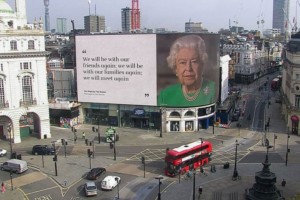
5. Click-hungry media feed panic
Corona is a healthcare crisis, but it has also become something more: a crisis of fear. The 24/7 feed of anxiety through our TV, computer and phone screens has created a social panic of unprecedented scale and speed. This has spiralling impacts on billions of people’s mental, social and material well-being, and is used by governments to justify brutal power grabs.
Here are a few basic observations about media coverage of coronavirus:
- The pandemic has swiftly achieved almost total media dominance, eclipsing every other issue. Even back in January, as a study in Time magazine showed, corona had received extraordinary coverage in English speaking media – for example, more than 20 times as many headlines as the Ebola outbreak in its first month.
- It is largely framed in terms of fear and death. Back in February, media scholar Karin Wahl-Jorgensen analysed the use of fear language in major newspaper reporting. Social media platforms ramp up this sensationalism. A post presenting cautious analysis is unlikely to go far – as opposed to a viral tweet thread like “HOLY MOTHER OF GOD […] the most virulent virus epidemic the world has ever seen.”
- Coverage is pinned to simplified and obsessively reported numbers: the daily tally of “confirmed cases” and deaths. Questions about the accuracy and comparability of these headline figures may be discussed in a side note – but not allowed to get in the way of the constant countdown.
- It fixates on authority. While medical and scientific expertise are clearly extremely valuable they are subject to the distortions of the media and are open to being exploited by political leaders, who are either heroes to rally round, or castigated for failing to play their roles. Here the corona panic has elements of the classic sociological model of a “moral panic”, in which the media’s call on authorities to save us from a threat to society presents a serious threat of authoritarian abuse.
While capitalism isn’t the only force shaping these patterns, profit is again a crucial factor. Psychologists point out how “our minds like to jump to threatening headlines with big, alarming numbers”. But if that’s true, it isn’t simply a settled fact of human evolution – it is actively used and reinforced by the dominant media business model.
Most major media platforms have a financial model based on advertising. Advertising revenue depends on audience, meaning attracting the maximum possible views and “hits”. While this has been the case since the birth of the popular press in the 19th century, online technologies have accelerated the feedback loop between content and “clicks”.
The well-known market leader is Facebook’s algorithmic News Feed Editor, which automatically selects and targets news. More “traditional” media outlets, including state-backed broadcasters, now also have to compete with the social media giants and adopt their methods – or lose even more of their market share and relevance.
The upshot of this profit imperative is a constant and rapid bombardment of the most click-worthy images, figures, tragic anecdotes, and “hot takes”. We are left swimming in numbers, information, and anxiety, with no space for reflection and critical thinking. And if we’re unable to sort through the noise and form our own informed and considered views, all we can do is trust and obey the authorities.
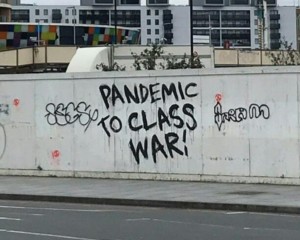
6. Gross inequality threatens lockdown poverty
Now the corona crisis is mutating into an economic crisis, as lockdown measures shut “non-essential” production, travel and consumption. In itself, switching off much of the capitalist economy is no bad thing: we really don’t need all the disposable plastic crap it churns out; wildlife, forests, and oceans could do with a breather. The problem is not “the economy”, but that billions of people rely on wages to eat and live.
Capitalism has created the most unequal society in human history: billionaires with unimaginable wealth, billions on the breadline. The lockdown affects us very differently depending on where we are in this pyramid.
To the rich, “stay at home” is no great hardship. For online professionals, or better off workers with permanent contracts, recipe swaps and yoga classes can take the edge off the frustration. To low-income, precarious and informal economy workers, it means the threat of unemployment and impoverishment. And as the crisis spreads to countries without welfare and healthcare safety nets, many millions will be hit.
In India, as Arundhati Roy writes, Modi has “borrowed the playbook from France and Italy” to impose a rapid lockdown on 1.38 billion people. In this context:
“The lockdown worked like a chemical experiment that suddenly illuminated hidden things. As shops, restaurants, factories and the construction industry shut down, as the wealthy and the middle classes enclosed themselves in gated colonies, our towns and megacities began to extrude their working-class citizens — their migrant workers — like so much unwanted accrual. […] The lockdown to enforce physical distancing had resulted in the opposite — physical compression on an unthinkable scale. […] The main roads might be empty, but the poor are sealed into cramped quarters in slums and shanties.”
In the rich world the curfew is, so far, largely maintained by agreement and social pressure. In India, where quarantine may mean starvation, it requires widespread “beating and humiliation” by police. In Kenya, one case of police enforcing lockdown by the lethal shooting of a thirteen year old boy has already been widely reported.
But here in Europe, too, when it comes to the margins of society – migrants, prisoners, the homeless – “stay at home” takes on very different meanings. We have already seen evictions and mass arrests in Athens, round-ups of refugees in Calais, at least eight dead in prison riots in Italy, as barbed wire fences go up around migrant accommodation in Croatia, and the army imposes quarantine on Roma settlements in Slovakia.
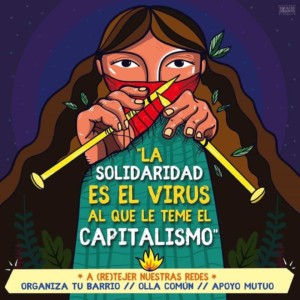
“Solidarity is the virus that capitalism fears.” To knit (back) our networks. Organise you neighbourhood, common pot, mutual aid.
Conclusion
This crisis is developing on multiple levels. The pandemic itself is just one. Then there are wider psychological and social impacts of continuing fear and isolation. There are political impacts as governments take advantage to rush through new powers. And there are the looming material impacts as millions are threatened with poverty and violent repression.
On all these levels, capitalism is a big part of the problem. The virus kills, and responses to it by states and corporations could kill many more. Many of these deaths are avoidable. We live in an age of enormous wealth, where vast amounts of human labour and natural resources are directed to produce trillions of dollars worth of anything from smart phones to fighter jets. These resources could be used to safeguard the health and wellbeing of all.
To quote Arundhati Roy again:
“Historically, pandemics have forced humans to break with the past and imagine their world anew. This one is no different. It is a portal, a gateway between one world and the next. We can choose to walk through it, dragging the carcasses of our prejudice and hatred, our avarice, our data banks and dead ideas, our dead rivers and smoky skies behind us. Or we can walk through lightly, with little luggage, ready to imagine another world. And ready to fight for it.”
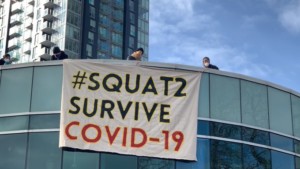
iTo put these numbers in context, Germany has more than 8 hospital beds per 1,000, and 29 intensive care beds per 100,000 – four times the UK figure. While of course Germany is also a capitalist economy, one factor here is arguably the relative strength of German social resistance to the aggressive neoliberal strain of capitalism that has rolled back health and welfare concessions in the UK and other countries in recent decades.


